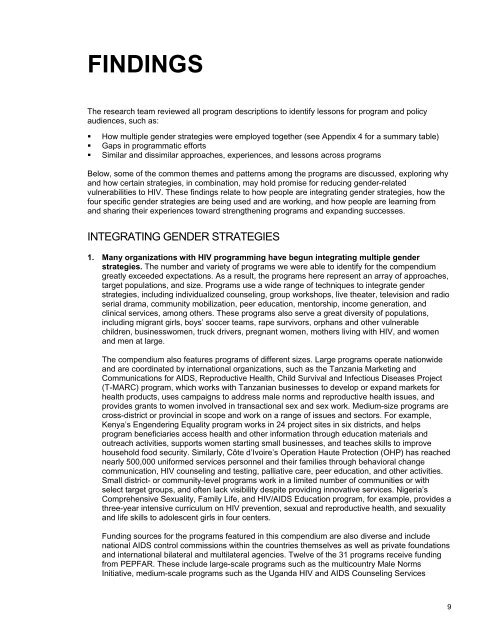Implementing Multiple Gender Strategies to Improve HIV and ... - ICRW
Implementing Multiple Gender Strategies to Improve HIV and ... - ICRW
Implementing Multiple Gender Strategies to Improve HIV and ... - ICRW
You also want an ePaper? Increase the reach of your titles
YUMPU automatically turns print PDFs into web optimized ePapers that Google loves.
FINDINGS<br />
The research team reviewed all program descriptions <strong>to</strong> identify lessons for program <strong>and</strong> policy<br />
audiences, such as:<br />
• How multiple gender strategies were employed <strong>to</strong>gether (see Appendix 4 for a summary table)<br />
• Gaps in programmatic efforts<br />
• Similar <strong>and</strong> dissimilar approaches, experiences, <strong>and</strong> lessons across programs<br />
Below, some of the common themes <strong>and</strong> patterns among the programs are discussed, exploring why<br />
<strong>and</strong> how certain strategies, in combination, may hold promise for reducing gender-related<br />
vulnerabilities <strong>to</strong> <strong>HIV</strong>. These findings relate <strong>to</strong> how people are integrating gender strategies, how the<br />
four specific gender strategies are being used <strong>and</strong> are working, <strong>and</strong> how people are learning from<br />
<strong>and</strong> sharing their experiences <strong>to</strong>ward strengthening programs <strong>and</strong> exp<strong>and</strong>ing successes.<br />
INTEGRATING GENDER STRATEGIES<br />
1. Many organizations with <strong>HIV</strong> programming have begun integrating multiple gender<br />
strategies. The number <strong>and</strong> variety of programs we were able <strong>to</strong> identify for the compendium<br />
greatly exceeded expectations. As a result, the programs here represent an array of approaches,<br />
target populations, <strong>and</strong> size. Programs use a wide range of techniques <strong>to</strong> integrate gender<br />
strategies, including individualized counseling, group workshops, live theater, television <strong>and</strong> radio<br />
serial drama, community mobilization, peer education, men<strong>to</strong>rship, income generation, <strong>and</strong><br />
clinical services, among others. These programs also serve a great diversity of populations,<br />
including migrant girls, boys’ soccer teams, rape survivors, orphans <strong>and</strong> other vulnerable<br />
children, businesswomen, truck drivers, pregnant women, mothers living with <strong>HIV</strong>, <strong>and</strong> women<br />
<strong>and</strong> men at large.<br />
The compendium also features programs of different sizes. Large programs operate nationwide<br />
<strong>and</strong> are coordinated by international organizations, such as the Tanzania Marketing <strong>and</strong><br />
Communications for AIDS, Reproductive Health, Child Survival <strong>and</strong> Infectious Diseases Project<br />
(T-MARC) program, which works with Tanzanian businesses <strong>to</strong> develop or exp<strong>and</strong> markets for<br />
health products, uses campaigns <strong>to</strong> address male norms <strong>and</strong> reproductive health issues, <strong>and</strong><br />
provides grants <strong>to</strong> women involved in transactional sex <strong>and</strong> sex work. Medium-size programs are<br />
cross-district or provincial in scope <strong>and</strong> work on a range of issues <strong>and</strong> sec<strong>to</strong>rs. For example,<br />
Kenya’s Engendering Equality program works in 24 project sites in six districts, <strong>and</strong> helps<br />
program beneficiaries access health <strong>and</strong> other information through education materials <strong>and</strong><br />
outreach activities, supports women starting small businesses, <strong>and</strong> teaches skills <strong>to</strong> improve<br />
household food security. Similarly, Côte d’Ivoire’s Operation Haute Protection (OHP) has reached<br />
nearly 500,000 uniformed services personnel <strong>and</strong> their families through behavioral change<br />
communication, <strong>HIV</strong> counseling <strong>and</strong> testing, palliative care, peer education, <strong>and</strong> other activities.<br />
Small district- or community-level programs work in a limited number of communities or with<br />
select target groups, <strong>and</strong> often lack visibility despite providing innovative services. Nigeria’s<br />
Comprehensive Sexuality, Family Life, <strong>and</strong> <strong>HIV</strong>/AIDS Education program, for example, provides a<br />
three-year intensive curriculum on <strong>HIV</strong> prevention, sexual <strong>and</strong> reproductive health, <strong>and</strong> sexuality<br />
<strong>and</strong> life skills <strong>to</strong> adolescent girls in four centers.<br />
Funding sources for the programs featured in this compendium are also diverse <strong>and</strong> include<br />
national AIDS control commissions within the countries themselves as well as private foundations<br />
<strong>and</strong> international bilateral <strong>and</strong> multilateral agencies. Twelve of the 31 programs receive funding<br />
from PEPFAR. These include large-scale programs such as the multicountry Male Norms<br />
Initiative, medium-scale programs such as the Ug<strong>and</strong>a <strong>HIV</strong> <strong>and</strong> AIDS Counseling Services<br />
9
















